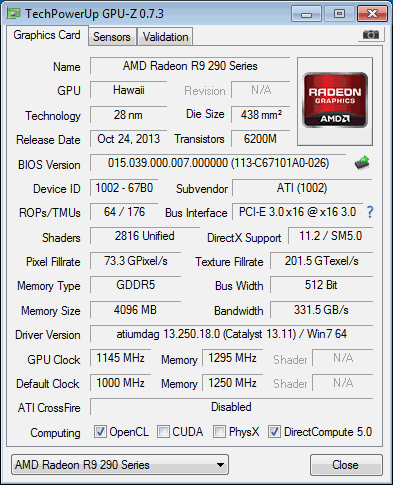 591
591
AMD Radeon R9 290X 4 GB Review
Temperatures & Clock Profiles »Overclocking
The overclocking results listed in this section were achieved with the default fan and voltage settings as defined in the VGA BIOS. Please note that every single sample overclocks differently which is why our results here can only serve as a guideline for what you can expect from your card.
Maximum overclock using the "Quiet" BIOS is 1145 MHz GPU clock (15% overclocking) and 1295 MHz memory (4% overclock).

With the "Uber" BIOS, we saw 1125 MHz GPU clock (13% overclocking) and 1575 MHz memory (26% overclock).
The increased GPU clock can be explained by the fact that PowerTune is less aggressive in "Uber" mode, which means PowerTune will not reduce the clocks as much as in "Quiet" mode. I have no explanation for the difference in memory clock, though. We've seen Hynix chips handle 1500 MHz and more easily, so this seems to be more of a BIOS-related bug. Only being able to reach 1575 MHz on memory in "Uber" mode confirms this suspicion.
Overclocked Performance
Using these clock frequencies, we ran a quick test of Battlefield 3 to evaluate the gains from overclocking.
Actual 3D performance gained from overclocking in "Quiet" mode is -1.7%. This is because the card is running at the temperature limit when not overclocked, having to reduce clocks to not overheat. Overclocking the card then has power output go up disproportionally, which actually has the card downclock even more to handle the heat.
When using the "Uber" BIOS, we see a 7.2% performance improvement.
Voltage Tuning
It has been a long-known fact that overclocking headroom increases with more operating voltage. Software voltage control has until recently been rare on graphics cards, and most users were not willing to risk their warranty by performing a soldering voltmod, but almost all current cards use voltage control to lower power consumption by throttling voltage in idle and low load.In this section, we will increase the GPU operating voltage step by step before recording our maximum possible clock speed. Voltage listed is the value reported by the measurement feature of the voltage controller. We left memory frequency at default for this test.
In order to avoid PowerTune throttling our card, we adjusted the power limit to +50% and set fan speed to 100%, which makes sure the card does not run into temperature limit. We used the "Uber" BIOS in these tests.
The following graph shows our sample's overclocking potential. GPU clock is represented by the blue line using the vertical clock scale on the left. The scale starts at the default clock to give a feel for the card's overclocking potential over its base clock. Temperature is plotted in red using the °C scale on the right side of the graph. An additional graph shows full system power draw in orange, measured at the wall socket while running the given voltage, clock, and temperature.

AMD's Radeon R9 290X shows fantastic clock scaling with GPU voltage, better than any GPU I've previously reviewed. The clocks do not show any signs of diminishing returns, which leads me to believe that the GPU could clock even higher with more voltage and cooling.
AMD's stock cooler is completely overwhelmed with the heat output of the card during voltage tweaking, though. Even at 100%, it could barely keep the card from overheating and was noisier than any cooler I've ever experienced. My neighbors actually complained, asking why I used power tools that late at night.
Power draw also increases immensely, going from just above 400 W for the whole system to around 650 W! To conclude, I expect extreme overlclockers with access to liquid nitrogen to love this card. Everyone else will probably find voltage tuning beyond +0.05 V to be too hot and too noisy.
Apr 7th, 2025 21:09 EDT
change timezone
Latest GPU Drivers
New Forum Posts
- USB case with dual USB-C and dual USB-A (0)
- 12v lines 0 reads occansionally (1)
- Someone run games on AMD BC-250 under Linux * Cut down PS5 die to 6 CPU cores 24 GPU cores for use in crypto mining (79)
- RX 9000 series GPU Owners Club (236)
- The coffee and tea drinkers club. (246)
- (omg)vflash | Fully Patched nvflash from X to Ada Lovelace [v5.780] (362)
- ThrottleStop booboo... somehow (3)
- Asus X670E Crosshair Crashes (4)
- Question about Intel Optane SSDs (68)
- 9070XT or 7900XT or 7900XTX (120)
Popular Reviews
- The Last Of Us Part 2 Performance Benchmark Review - 30 GPUs Compared
- UPERFECT UStation Delta Max Review - Two Screens In One
- ASUS Prime X870-P Wi-Fi Review
- PowerColor Radeon RX 9070 Hellhound Review
- Upcoming Hardware Launches 2025 (Updated Apr 2025)
- Sapphire Radeon RX 9070 XT Pulse Review
- Corsair RM750x Shift 750 W Review
- MCHOSE L7 Pro Review
- Sapphire Radeon RX 9070 XT Nitro+ Review - Beating NVIDIA
- DDR5 CUDIMM Explained & Benched - The New Memory Standard
Controversial News Posts
- NVIDIA GeForce RTX 5060 Ti 16 GB SKU Likely Launching at $499, According to Supply Chain Leak (159)
- MSI Doesn't Plan Radeon RX 9000 Series GPUs, Skips AMD RDNA 4 Generation Entirely (146)
- Microsoft Introduces Copilot for Gaming (124)
- AMD Radeon RX 9070 XT Reportedly Outperforms RTX 5080 Through Undervolting (119)
- NVIDIA Reportedly Prepares GeForce RTX 5060 and RTX 5060 Ti Unveil Tomorrow (115)
- Over 200,000 Sold Radeon RX 9070 and RX 9070 XT GPUs? AMD Says No Number was Given (100)
- NVIDIA GeForce RTX 5050, RTX 5060, and RTX 5060 Ti Specifications Leak (97)
- Nintendo Switch 2 Launches June 5 at $449.99 with New Hardware and Games (92)